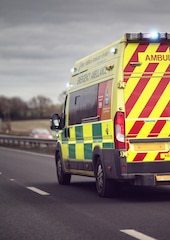
More than 16% of ambulance callouts in Scotland were alcohol-related in 2019. This is what we found in our new study using data provided by the Scottish Ambulance Service (SAS) and is three times higher than previous estimates. The burden was even higher over weekends (18.5%), peaking on Friday and Saturday nights when the percentage of alcohol-related callouts was 28%.
Alcohol and emergency services
Alcohol constitutes a significant burden on emergency services in the UK, with the potential to undermine or delay emergency service provision to other incidents. This is also true for ambulance services, which often represent patients’ first – and sometimes only – contact with health services. However, there are concerns that current estimates underestimate the actual burden of alcohol for ambulance services.
The study
In a collaboration between the University of Glasgow, SAS, University of Stirling and University of Sheffield, we developed a new approach to identifying alcohol-related ambulance callouts. The approach involves a new algorithm that is integrated into SAS systems to automatically identify alcohol-related callouts using electronic patient records. After every callout, paramedics complete a patient record including free-text fields regarding the circumstances of the callout and patient characteristics. By looking at the most frequent combination of words in callout reports, we built an algorithm capable of classifying ambulance callouts as alcohol-related or not.
Findings
The new method not only provides a much more accurate estimate of the number of alcohol-related callouts, but also enables analysis of trends, location and demographic characteristics of such callouts. For instance, almost two thirds of alcohol-related callouts are to men, which is almost 20% of all ambulance callouts to men. A greater burden of alcohol-related call-outs were to locations in areas with high levels of socio-economic deprivation and on bank holidays, with a peak on the 1st of January which has on average 200 more callouts compared to any other day of the year in Scotland. Beyond the clinical and logistical effort, these callouts also give rise to an economic burden. Our estimate, based on the average cost of an ambulance call-out, is that in 2019 alcohol-related callouts cost almost £31.5m to SAS.
This study adds to the evidence base around the impact of alcohol on society. Furthermore, these data can be used to monitor trends over time and inform alcohol policy decision making both at local and national levels. We are also aware of the potential of similar approaches in other contexts (e.g. ambulance services outside Scotland) or agencies (such as the police) doing similar work.
This work is part of the IMPAACT (The Impact of Minimum Unit Pricing of Alcohol on Ambulance Call-outs in Scotland) study led by Professor Niamh Fitzgerald at the University of Stirling. The work was funded by the Scottish Government Chief Scientist Office (HIPS 18/57) and published in the International Journal of Environmental Research and Public Health.
Written by Francesco Manca and Professor Jim Lewsey, University of Glasgow and Professor Niamh Fitzgerald, University of Stirling
All IAS Blogposts are published with the permission of the author. The views expressed are solely the author’s own and do not necessarily represent the views of the Institute of Alcohol Studies
